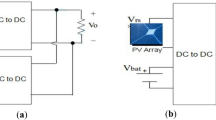Abstract
This article investigates modeling and simulation of the off-grid photovoltaic (PV) system, and elimination of harmonic components using an LC passive filter. Pulse width modulation (PWM) inverter is used to convert the direct current to alternating current. It is very important in terms of energy quality that the inverter output current total harmonic distortion (THDI) is below the value given by standards. Harmonic components have negatively effect on off-grid PV power system. THDI should be kept below a certain level in order to prevent damage to the equipment in the off-grid system and to ensure a higher quality energy flow to reduce the total harmonic distortion (THD) of the solar inverter output current; LC passive filter must be connected to the output of the PWM inverter. There are many types of passive filters for solar inverters. One of the most widely used filter types is the LC filter. LC filters are used in off-grid systems. LC filter is smaller in size and lower cost than other filters. But it is more complicated to determine the parameters of the LC filter. Therefore, in order for the system to remain in a steady state, the parameters must be accurately calculated and analyzed. In this study, the output power of the solar inverter, switching frequency, bus voltage etc. values were determined and LC filter parameters were calculated. Since high inductance values are used in LC filters, the voltage drop increases in these filters. To reduce the voltage drop, the DC bus voltage must be increased, which increases the switching losses. LC filter is connected between the inverter and the nonlinear load to filter the harmonic components produced by the DC/DC boost converter, DC/AC inverter and non-linear load. Matlab/Simulink program was used in Simulation and analysis of off-grid solar system. Solar inverter output current THD was measured as 91.55%. After the LC filter is connected to the system, this value has dropped to 2.62%.









Similar content being viewed by others
References
Kececioglu OF, Acikgoz HC, Yildiz A, Sekkeli M (2017) Power quality improvement using hybrid passive filter configuration for wind energy systems. J Electr Eng Technol 12:207–216
Cho YS, Cha H (2011) A single-tuned passive harmonic filter design using transfer function approach for industrial process application. Int J Mech Autom 1:90–96
Wakileh GJ (2001) Power system harmonics fundamentals, analysis and filter design. Springer, New York
Belchior FN, Lima LR, Ribeiro PF, Castro FC (2015) A novel approach towards passive filter placement. In: Proceedings of 2015 IEEE power and energy society general meeting
Lopes LAC, Lienhardt AM (2003) A simplified nonlinear power source for simulating PV panels. In: IEEE 34th power electronics specialist conference, vol 4, pp 1729–1734
Chandrasekaran G, Periyasamy S, Rajamanickam KP (2020) Minimization of test time insystem on chip using artificial intelligence-based test scheduling techniques. Neural Comput Appl 32:5303–5312. https://doi.org/10.1007/s00521-019-04039-6
Bhonsle DC, Kelkar RB (2011) Harmonic pollution survey and simulation of passive filter using Matlab. In: International conference on recent advancements in electrical, electronics and control engineering (ICONRAEeCE), Sivakasi, pp 230–236
Wai RJ, Wang WH, Lin CY (2008) High-performance stand-alone photovoltaic generation system. IEEE Trans Ind Electron 55:240–250
Nassif AB, Xu W, Freitas W (2009) An investigation on the selection of filter topologies for passive filter applications. IEEE Trans Power Deliv 24:1701–1712
Praveen Kumar C, Kaliamoorthy M, Prabha SU (2021) An investigation of testing and monitoring mechanisms for stator insulationsystem. http://www.jcreview.com/?mno=97976. Accessed 04 Jan 2021. https://doi.org/10.31838/jcr.07.12.250
Calzo GL, Lidozzi A, Solero L, Crescimbini F (2015) LC filter design for on-grid and off-grid distributed generating units. IEEE Trans Ind Appl 51:1639–1650
Sabir R, Emrullah O, Nuri MA, Serhat EB (2015) Reducing the effects of harmonics on the electrical power systems with passive filters. Bitlis Eren Univ J Sci Tech 5:1–10
Tan RHG, Tai PLJ, Mok VH (2015) Solar irradiance estimation based on photovoltaic module short circuit current measurement. In: IEEE international conference on smart instrumentation, measurement and applications (ICSIMA), June 2015. https://doi.org/10.1109/PVSC.2015.7355816
Dastfan A, Yassami H, Rafiei MR (2014) Optimum design of passive harmonic filter by using game theory concepts. Intell Syst Electr Eng 4:20–30
Gow JA, Manning CD (2000) Photovoltaic converter system suitable for use in small scale stand-alone or grid connected applications. Proc Inst Electr Eng Electr Power Appl 147:535–543
Praveen Kumar C, Surendar K, Ronak Jain N (2020) Soft switching hybrid resonant boost converter for energy harvesting application. In: 2020 3rd international conference on intelligent sustainable systems (ICISS), Thoothukudi, India, pp 1416–1422. https://doi.org/10.1109/ICISS49785.2020.9315922
Motahhir S, El Hammoumi A, El Ghzizal A (2019) Photovoltaic system with quantitative comparative between an improved MPPT and existing INC and P&O methods under fast varying of solar irradiation. Energy Rep 5:341–350
Cangi H, Adak S, Yilmaz, AS (2019) Estimation of harmonic distortions with artificial neural networks in low irradiation level. In: International symposium on advanced engineering technologies, Kahramanmaraş/Turkey, 2th–4th
Chandrasekaran G et al (2020) Test scheduling of system-on-chip “using dragonfly and ant lion optimization algorithms.” J Intell Fuzzy Syst 2020:1–13. https://doi.org/10.3233/JIFS-201691
http://www.solidstatetechnology.us/index.php/JSST/article/view/7726
Kim H, Sul SK (2011) A novel filter design for output LC filters of PWM inverters. J Power Electron 11:74–81
Author information
Authors and Affiliations
Corresponding author
Additional information
Publisher's Note
Springer Nature remains neutral with regard to jurisdictional claims in published maps and institutional affiliations.
Rights and permissions
About this article
Cite this article
Adak, S. Harmonics Mitigation of Stand-Alone Photovoltaic System Using LC Passive Filter. J. Electr. Eng. Technol. 16, 2389–2396 (2021). https://doi.org/10.1007/s42835-021-00777-7
Received:
Revised:
Accepted:
Published:
Issue Date:
DOI: https://doi.org/10.1007/s42835-021-00777-7




